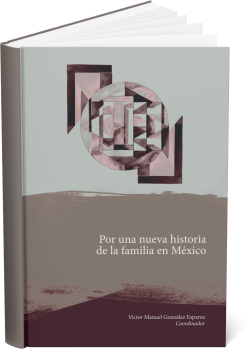FOR A NEW HISTORY OF THE FAMILY IN MEXICO
Synopsis
The effort made by the Academic Body of "History of Culture, Society, and Institutions in Mexico" from the History Department of the Autonomous University of Aguascalientes has enabled the organization of events that are already a benchmark in the academic life of our institution. We are particularly referring to the Colloquium on Genealogy and Family History, which, thanks to the various contributions received in its seventh edition, has become a new event related to the social history of families, transforming the original references of genealogy into a social history.
Hence, the title could be "For a New History of Families," in the plural, since the essays the reader will find precisely account not only for the historiographical changes that have gradually occurred in this colloquium, where social and family diversity is portrayed, but also for the fact that our event has increasingly acquired an international character given the need to rethink our family histories.
One of the themes that is increasingly gaining ground in these historiographical transformations is the study of elite families, as they are the ones who take the greatest care in preserving documents related to their genealogy, their properties, or their ties with other elite families. In such a way that for scholars of the elites, the works gathered in this book are undoubtedly a mandatory reference, as they show us the political and commercial relationships that allowed the formation of the wealth of some power groups. We can also find in this book a creative use of genealogy, particularly from the possibility of achieving prosopographic histories of a collective, a study that has been proposed by Dr. Thomas Hillerkuss based on his tireless work in gathering thousands of biographical records of the main actors of New Galicia in the 16th and 17th centuries, a task that can already be recognized in the publication of the first volumes of the Biographical Dictionary of New Hispanic Western.
Other essays included in this book deal with miscegenation and the need to study the process more broadly, beyond the traditional ideas of the union between Spaniards and Indigenous people, to certainly incorporate the Afro-Mestizo heritage and, as one of the included works shows, the Filipino heritage.
In short, the reader will find not a fixed idea of the family but a series of family stories, in their typological and social diversity, which allows us to rethink the history of one of the central institutions in the social, economic, and political life of Mexico and other regions. We hope that the reader can appreciate the great work carried out by the authors, but also by the collaborators who have kindly contributed to the publication of this book and, of course, to the organization of the various colloquia, which have allowed for the offering of new family stories.
Chapters
-
Foreword
-
Social history and its relationships with prosopography and genealogy.Successes, mistakes, and manipulations
-
Reconstruction of the Cuéllar genealogy in the Highlands of Jalisco.Parish of Our Lady of the Incarnation, 1681-1822
-
Debating miscegenation.Return to the sources
-
Mestizaje and quality in the parish of Santa María Tepetlaoxtoc during the late colonial period and the early years of Independence
-
The family and types of households in Uruapan in the final years of the colonial period (1742-1810).A view through their registers
-
Heritage and cultural impact of Gonzalo Guerrero and Zazil Há as the first mestizo family of Mexico
-
Spanish mestizos in the Philippines, 17th century
-
Juan de Montoro: more biographical and genealogical news
-
Selling and buying from relatives.The manumission of slaves of African origin through the liberation of their children. San Luis Potosí, 17th and 18th centuries
-
Dynamics of marital kinship in two Nahua towns of the province of Tlaxcala: Xiloxoxtla and Tlacochcalco, 1656-1832
-
The Vértiz.A family of power in New Spain
-
"Being opposed to such a state": the annulment trial of Mrs. Juana María de Beregaña and Captain Don Manuel López Cotilla (1798-1800)
-
Occupation and population in León, Guanajuato, in the late 19th century.The case of Coecillo and Barrio de Arriba
-
Families of Michoacan heroes: the Manzo de Cevallos, genealogical link with the López Rayón and the Ocampo Manzo
-
Marriage and family as salvation in times of expulsion in Mexico, 1838-1839
-
The Renners and Gavitos: two foreign families in Puebla society during the Porfirio Díaz era
-
Familial sentiment and heritage transmission on the threshold of death: the Vizcayan case in the 19th century
-
Between commerce and politics.Kinship networks and social dynamics in three prominent families settled in Aguascalientes during the 19th century: the Gómez Hornedo, Güinchard, and Sagredo García Roja s
-
The genealogical method as a tool for the study of dances: examples from Norogachi, Chihuahua, and Tepexpan, State of Mexico
-
The Casa de la Bola Museum, guardian of the Haghenbeck family archive
-
Family representations, photographic images in the realm of the photo studio. Aguascalientes, 1948 to 2008
-
A personal archive to build the family history.The "treasure chest" of María del Refugio Rangel Aguilar (1906-1975)
-
The "treasure chest" of María del Refugio Rangel Aguilar (1906-1975)
-
Masculinities and Violence in 20th Century Aguascalientes: A Study of Three Cases of Violence Against Women from a Hemerographic Approach

Downloads
Published
Series
Categories
License

This work is licensed under a Creative Commons Attribution-ShareAlike 4.0 International License.






